Green Streets to Serve Urban Sustainability: Benefits and Typology
Abstract
:1. Introduction
1.1. Definition of a Green Street
1.2. Green Street versus Street
2. Materials and Methods
3. Results
3.1. Potential Benefits of Green Street
3.2. Green Street Typology: Form-Based Approach
4. Discussion
- Reducing treatment volume and pollutants: Vegetated roof, rooftop disconnection, permeable pavement, grass channel, dry swale, bioretention, infiltration, extended detention pond, sheet flow to filter/open space;
- Reducing pollutants: Wet swale, filtering practices, constructed wetland, wet ponds, manufactured BMP.
5. Conclusions
Funding
Acknowledgments
Conflicts of Interest
Appendix A
| Status | Green Street Projects | Implemented Typology |
|---|---|---|
| Constructed Projects | 21st Street, Paso Robles, CA | 1.B-1. Extended planter: b type, 2.C-1. Median |
| Avalon Green Alley Network Project, Los Angeles, CA | 4.A. Permeable paving | |
| Elmer Avenue Neighborhood Project, Los Angeles, CA | 2.A-4. Swale type: Natural | |
| El Cerrito Green Streets Project (First Site) Madison Site, El Cerrito, CA | 2.A-1. Cell type: Planter | |
| El Cerrito Green Streets Project (Second Site) Eureka Site, El Cerrito, CA | 2.A-1. Cell type: Planter | |
| Elmer Paseo Stormwater Improvements, Los Angeles, CA | 2.A-4. Swale type: Retention, 4.A. Permeable paving | |
| Glen Oaks Bioswales and Drywells Project, Los Angeles, CA | 2.A-1. Cell type: Planter | |
| Hacienda Avenue Green Street Improvement Project, Campbell, CA | 2.A-1. Cell type: Planter, 2.B-1. Extended planter | |
| Malibu Hills Stormwater Enhancement and Green Street Project, Calabasas, CA | 2.C-1. Median | |
| Ocean Park Boulevard, Santa Monica, CA | 2.A-3. Swale type: Planter | |
| Oros Green Street, Los Angeles, CA | 2.A-1. Cell type: Planter | |
| Riverdale Avenue Green Street Demonstration Project, Los Angeles, CA | 2.A-1. Cell type: Planter | |
| The Park Avenue Green Streets, Sam Jose, CA | 2.A-1. Cell type: Planter, 1.C-1. Island | |
| Woodman Avenue River Project, Panorama City, CA | 2.C-1. Median | |
| Buchanan Green Street Project, Mount Rainier, MD | 1.B-1. Extended planter: a type, 2.A-4. Swale type: Natural | |
| Dennis Avenue Green Street, Montgomery County, MD | 2.A-5. Covered cell: Tree pit, 2.A-2. Cell type: Natural, 4.A. Permeable paving | |
| Person Street Innovative Stormwater Greenscape Project, Fayetteville, NC | 2.B-1. Extended planter, 4.A. Permeable paving | |
| Maywood Avenue Stormwater Volume Reduction Project, Toledo, OH | 2.A-1. Cell type: Planter | |
| 2110 Strong Rd Se, Salem, OR (Pringle Creek Green Street Project) | 1.B-1. Extended planter: a type, 1.B-1. Extended planter: b type | |
| Holman Pocket Park and Green Street Bike Boulevard Project, Portland, OR | 1.B-2. Pocket Rain Garden | |
| NE Fremont Street Green Street Project, Portland, OR | 2.B-1. Extended curb | |
| Ne Siskiyou Green Street Project, Portland, OR | 2.B-1. Extended curb | |
| Se Ankeny Green Street Project, Portland, OR | 2.B-1. Extended curb | |
| Se Spokane Green Street Bicycle Boulevard Project, Portland, OR | 1.B-1. Extended planter: b type | |
| SW 12th Avenue Between SW Montgomery And SW Mill, Portland, OR | 2.A-1. Cell type: Planter | |
| SW 19th Residential Street And Stormwater Project (between SW Taylors Ferry Road and SW Marigold Street), Portland, OR | 1.B-2. Pocket Rain Garden | |
| Sw Huber Green Street, Portland, OR | 2.B-1. Extended planter | |
| Southwest Stephenson Street Roadside Swales, Portland, OR | 2.B-1. Extended curb | |
| Allen Street Rain Gardens, State College, PA | 2.B-1. Extended curb | |
| Stormwater Planters at Columbus Square, Philadelphia, PA | 2.A-1. Cell type: Planter | |
| Queen Lane Water Treatment Plant, Philadelphia, PA | 2.B-1. Extended curb | |
| Waterview Recreation Center, Philadelphia, PA | 2.A-1. Cell type: Planter, 2.A-5: Covered cell: Tree pit, 4.A. Permeable paving | |
| Deaderick Street, Nashville, TN | 2.A-1. Cell type: Planter, 1.B-1. Extended planter: a type, 2.C-1. Median, 4.A. Permeable paving | |
| Congo Street Initiative, Dallas, Tx | 4.A. Permeable paving | |
| John Marshall Drive Green Street, Arlington, VA (between Yorktown Boulevard and Williamsburg Boulevard) | 2.C-1. Median | |
| Williamsburg Boulevard Between 33rd Rd North and 35th Street North, Arlington, VA | 2.C-1. Median | |
| Winslow Way, Bainbridge Island, WA (at Ericksen Ave NE) | 2.A-1. Cell type: Planter | |
| 2nd Avenue NW, Seattle, WA (from NW 117th St. to 120th St.) | 2.A-4. Swale type: Natural | |
| Broadview Green Grid, Seattle, WA | 2.A-2. Cell type: Natural | |
| In-Progress | 103rd Street Green Improvement Project, LA Co, CA | 2.A-3. Swale type: Planter |
| Projects | Rumrill Boulevard, San Pablo, CA | 2.C-1. Median, 2.A-3. Swale type: Planter in progress |
| Walnut Street Reconstruction and Streetscape Project, Agawam, MA | 2.A-1. Cell type: Planter, 2.A-4. Swale type: Natural in progress | |
| Flower Avenue Green Street Project, Takoma Park, MD | In progress 2.A-1. Cell type: Planter | |
| Pringle Creek Green Street, Salem, OR (may be same as 2110 Strong Rd Se, Salem, Oregon) | 4.A. Permeable paving | |
| Lid Retrofit for The Ashland Municipal Parking, Ashland, VA | 2.A-4. Swale type: Natural (parking lot), bioretention, permeable paving |
References
- Sieber, J.; Pons, M. Assessment of Urban Ecosystem Services using Ecosystem Services Reviews and GIS-Based Tools. Procedia Eng. 2015, 115, 53–60. [Google Scholar] [CrossRef]
- Demuzere, M.; Orru, K.; Heidrich, O.; Olazabal, E.; Geneletti, D.; Orru, H.; Bhave, A.G.; Mittal, N.; Feliu, E.; Faehnle, M. Mitigating and Adapting to Climate Change: Multi-Functional and Multi-Scale Assessment of Green Urban Infrastructure. J. Environ. Manag. 2014, 146, 107–115. [Google Scholar] [CrossRef] [PubMed]
- Baruch, E.M.; Voss, K.A.; Blaszczak, J.R.; Delesantro, J.; Urban, D.L.; Bernhardt, E.S. Not All Pavements Lead to Streams: Variation in Impervious Surface Connectivity Affects Urban Stream Ecosystems. Freshw. Sci. 2018, 37, 673–684. [Google Scholar] [CrossRef]
- Paul, M.J.; Meyer, J.L. Streams in the Urban Landscape. Annu. Rev. Ecol. Syst. 2008, 32, 207–231. [Google Scholar] [CrossRef]
- Zhang, Y.; Odeh, I.O.A.; Han, C. Bi-Temporal Characterization of Land Surface Temperature in Relation to Impervious Surface Area, NDVI and NDBI, Using a Sub-Pixel Image Analysis. Int. J. Appl. Earth Obs. Geoinf. 2009, 11, 256–264. [Google Scholar] [CrossRef]
- Winter, H. Making Sense of Multiple Extreme Weather Events. Significance 2017, 14, 6–7. [Google Scholar] [CrossRef]
- Hayhoe, K.; Sheridan, S.; Kalkstein, L.; Greene, S. Climate Change, Heat Waves, and Mortality Projections for Chicago. J. Great Lakes Res. 2010, 36, 65–73. [Google Scholar] [CrossRef]
- Zhang, W.; Villarini, G.; Vecchi, G.A.; Smith, J.A. Urbanization Exacerbated the Rainfall and Flooding Caused by Hurricane Harvey in Houston. Nature 2018, 563, 384–388. [Google Scholar] [CrossRef]
- Tzoulas, K.; Korpela, K.; Venn, S.; Yli Pelkonen, V.; Kazmierczak, A.; Niemela, J.; James, P. Promoting Ecosystem and Human Health in Urban Areas Using Green Infrastructure: A Literature Review. Landsc. Urban Plan. 2007, 81, 167–178. [Google Scholar] [CrossRef]
- Beery, T. Engaging the Private Homeowner: Linking Climate Change and Green Stormwater Infrastructure. Sustainability 2018, 10, 4791. [Google Scholar] [CrossRef]
- Meerow, S.; Newell, J.P. Spatial Planning for Multifunctional Green Infrastructure: Growing Resilience in Detroit. Landsc. Urban Plan. 2017, 159, 62–75. [Google Scholar] [CrossRef]
- American Rivers; The Center for Neighborhood Technology; The Great Lakes and St. Lawrence Cities Initiative. Green Infrastructure Portfolio Standard. Available online: http://www.mayorsinnovation.org/images/uploads/pdf/4_-_Green_Infrastructure_Portfolio_Standard.pdf (accessed on 1 August 2019).
- Copeland, C. Green Infrastructure and Issues in Managing Urban Stormwater; CRS Report; R43131; Congressional Research Service: Washington, DC, USA, 2016.
- Clean Water America Alliance. Barriers and Gateways to Green Infrastructure; Clean Water America Alliance: Washington, DC, USA, 2011. [Google Scholar]
- Kilometers of Public Roads and Streets in the United States by Type of Surface, table 01 04 mq418. US Department of Transportation, Bureau of Transportation Statistics. Available online: https://www.bts.gov/content/kilometers-public-roads-and-streets-united-states-type-surface (accessed on 1 July 2019).
- Southworth, M.; Ben Joseph, E. Streets and the Shaping of Towns and Cities; Island Press: Washington, DC, USA, 2003. [Google Scholar]
- Tilley, J.S.; Slonecker, E.T. Quantifying the Components of Impervious Surfaces; Open-File Report; U.S. Department of Transportation, Federal Highway Administration: Washington, DC, USA, 2006.
- Newell, J.P.; Seymour, M.; Yee, T.; Renteria, J.; Longcore, T.; Wolch, J.R.; Shishkovsky, A. Green Alley Programs: Planning for a Sustainable Urban Infrastructure? Cities 2013, 31, 144–155. [Google Scholar] [CrossRef]
- City of Portland. NE Siskiyou Green Street Project; City of Portland: Portland, OR, USA, 2005. [Google Scholar]
- Portland Environmental Services. Portland Green Street Program. Available online: https://www.portlandoregon.gov/bes/45386 (accessed on 17 August 2019).
- City of Arlington. Green Streets. Available online: https://projects.arlingtonva.us/programs/stormwater-management/green-streets/ (accessed on 17 September 2019).
- Environmental Protection Agency. What is Green Infrastructure? Available online: http://www.epa.gov/green-infrastructure/what-green-infrastructure#greenstreetsandalleys (accessed on 1 November 2018).
- City of Philadelphia. City of Philadelphia Green Streets Design Manual; City of Philadelphia: Philadelphia, PA, USA, 2014. [Google Scholar]
- Environmental Protection Agency. A Conceptual Guide to Effective Green Streets Design Solutions; Environmental Protection Agency: Washington, DC, USA, 2009.
- Water Environment Research Foundation. Green Streets Basics and Design: BMPs to Programs. Available online: https://www.werf.org/liveablecommunities/toolbox/gst_design.htm (accessed on 29 July 2019).
- Lukes, R.; Kloss, C.; Low Impact Development Center. Municipal Handbook: Green Streets; Managing Wet Weather with Green Infrastructure; EPA-833-F-08-009; US Environmental Protection Agency: Washington, DC, USA, 2008; p. 19.
- Metro (Portland Metropolitan Area). Green Streets: Innovative Solutions for Storwmater and Stream Crossings; Metro: Portland, OR, USA, 2002. [Google Scholar]
- National Association of City Transportation Officials. NACTO Urban Street Design Guide Overview; National Association of City Transportation Officials: New York, NY, USA, 2012.
- Seattle. Seattle Right-Of-Way Improvements Manual. Available online: http://www.seattle.gov/rowmanual/manual/6_2.asp (accessed on 1 December 2018).
- Dumbaugh, E.; Gattis, J.L. Safe Streets, Livable Streets. J. Am. Plan. Assoc. 2005, 71, 283–300. [Google Scholar] [CrossRef]
- Schueler, T.R.; Fraley McNeal, L.; Cappiella, K. Is Impervious Cover Still Important? Review of Recent Research. J. Hydrol. Eng. 2009, 14, 309–315. [Google Scholar] [CrossRef]
- Yin, R.K. The Case Study as a Serious Research Strategy. Knowl. Creat. Diffus. Util. 1981, 3, 97–114. [Google Scholar] [CrossRef]
- Pioneer Valley Planning Commission. Pioneer Valley Sustainability Toolkit; PVPC: Springfield, MA, USA, 2015. [Google Scholar]
- District Department of Transportation. Greening DC Streets: A Guide to Green Infrastructure in the District of Columbia; District Department of Transportation: Washington, DC, USA, 2014.
- Carlson, M.; Caughey, W.; Ward, N. Green Streets Guidebook for the City of Holyoke, Massachusetts; City of Holyoke: Holyoke, MA, USA, 2014. [Google Scholar]
- City of Cleveland. Cleveland Complete and Green Streets; City of Cleveland: Cleveland, OH, USA, 2013. [Google Scholar]
- Chicago Department of Transportation. The Chicago Green Alley Handbook: An Action Guide to Create a Greener, Environmentally Sustainable Chicago; Chicago Department of Transportation: Chicago, IL, USA, 2010.
- Ratner, C. Cultural Psychology: Theory and Method; Kluwer Academic/Plenum Publishers: New York, NY, USA, 2002. [Google Scholar]
- City of New York; Department of Environmental Protection; Bureau of Engineering Design and Construction. Standard Designs and Guidelines for Green Infrastructure Practices; NYC Environmental Protection: New York, NY, USA, 2017.
- Portland Environmental Services. City of Portland Stormwater Management Manual; City of Portland: Portland, OR, USA, 2016. [Google Scholar]
- Im, J. A Study of the Planning and Design Process of Green Infrastructure Focusing on Green Street Approach: Guidance to Successful Implementation. In Future Resilience; International Federation of Landscape Architects: Singapore, 2018; pp. 594–603. [Google Scholar]
- Matsuno, H.; Chiu, S. SEA Street. Seattle, USA. Available online: https://nacto.org/wp-content/uploads/2015/04/stormwater_management_challenge_matsuno.pdf (accessed on 22 October 2019).
- Birkenstein Innodrain. From Sieker: The Stormwater Experts Website. Available online: https://www.sieker.de/en/projects-and-references/planning-projects/project/birkenstein-innodrain-32.html (accessed on 10 October 2019).
- Im, J.; Guerrero, M.; Condon, D. ReThinking Small Alleys: A Path to Big Hope. In Proceedings of the 2018 ASLA Conference on Landscape Architecture, Philadelphia, PA, USA, 19–22 October 2018. [Google Scholar]
- Girling, C.; Kellett, R. Skinny Streets and Green Neighborhoods: Design for Environment and Community; Island Press: Washington, DC, USA, 2005. [Google Scholar]
- Butler, D.; Davies, J.W. Urban Drainage, 3rd ed.; Spon Press: New York, NY, USA, 2011. [Google Scholar]
- Virgina Water Permitting Division. Virginia Runoff Reduction Method; Commonwealth of Virginia Department of Environmental Quality Water Permitting Division: Richmond, VA, USA, 2016.
- Bowles, G. Impervious Surface-An Environmental Indicator. Land Use Educ. 2002, 1–2. [Google Scholar]
- Sung, C.Y.; Yi, Y.; Li, M.H. Impervious Surface Regulation and Urban Sprawl as Its Unintended Consequence. Land Use Policy 2013, 32, 317–323. [Google Scholar] [CrossRef]
- Boyle, C.; Gamage, G.B.; Burns, B.; Knight Lenihan, S.; Schwendenmann, L.; Thresher, W. Greening Cities: A Review of Green Infrastructure; University of Auckland: Auckland, New Zealand, 2014. [Google Scholar]
- Benedict, M.A.; McMahon, E.T. Green Infrastructure: Linking Landscapes and Communities; Island Press: Washington, DC, USA, 2006. [Google Scholar]
- Randolph, J. Environmental Land Use Planning and Management; Island Press: Washington, DC, USA, 2004. [Google Scholar]
- Roy, A.H.; Wenger, S.J.; Fletcher, T.D.; Walsh, C.J.; Ladson, A.R.; Shuster, W.D.; Thurston, H.W.; Brown, R.R. Impediments and Solutions to Sustainable, Watershed-Scale Urban Stormwater Management: Lessons from Australia and the United States. Environ. Manag. 2008, 42, 344–359. [Google Scholar] [CrossRef]
- American Society of Landscape Architects. Green Infrastructure: Over View. Available online: https://www.asla.org/ContentDetail.aspx?id=43532 (accessed on 4 April 2018).
- United Nation. Our Common Future; Oxford University Press: Oxford, UK, 1987. [Google Scholar]
- Mell, I.C. Can Green Infrastructure Promote Urban Sustainability? Proc. Inst. Civ. Eng. Eng. Sustain. 2009, 162, 23–34. [Google Scholar] [CrossRef]
- Brown, B.J.; Hanson, M.E.; Liverman, D.M.; Merideth, R.W. Global Sustainability: Toward Definition. Environ. Manag. 1987, 11, 713–719. [Google Scholar] [CrossRef]
- Pearson, C. Down to Business: Multinationals, the Environment and Development; World Resources Institute: Washington, DC, USA, 1985. [Google Scholar]
- Ritchie, A.; Thomas, R. Sustainable Urban Design: An Environmental Approach; Taylor Francis: London, UK; New York, NY, USA, 2009. [Google Scholar]
- Lele, S.M. Sustainable Development A Critical Review. World Dev. 1991, 19, 607–621. [Google Scholar] [CrossRef]
- Tolba, M.K. The Premises for Building a Sustainable Society—Address to the World Commission on Environment and Development; United Nations Environment Programme: Nairobi, Kenya, 1984. [Google Scholar]
- Odum, E.P. Fundamentals of Ecology, 5th ed.; Thomson Brooks/Cole: Belmont, CA, USA, 2005. [Google Scholar]
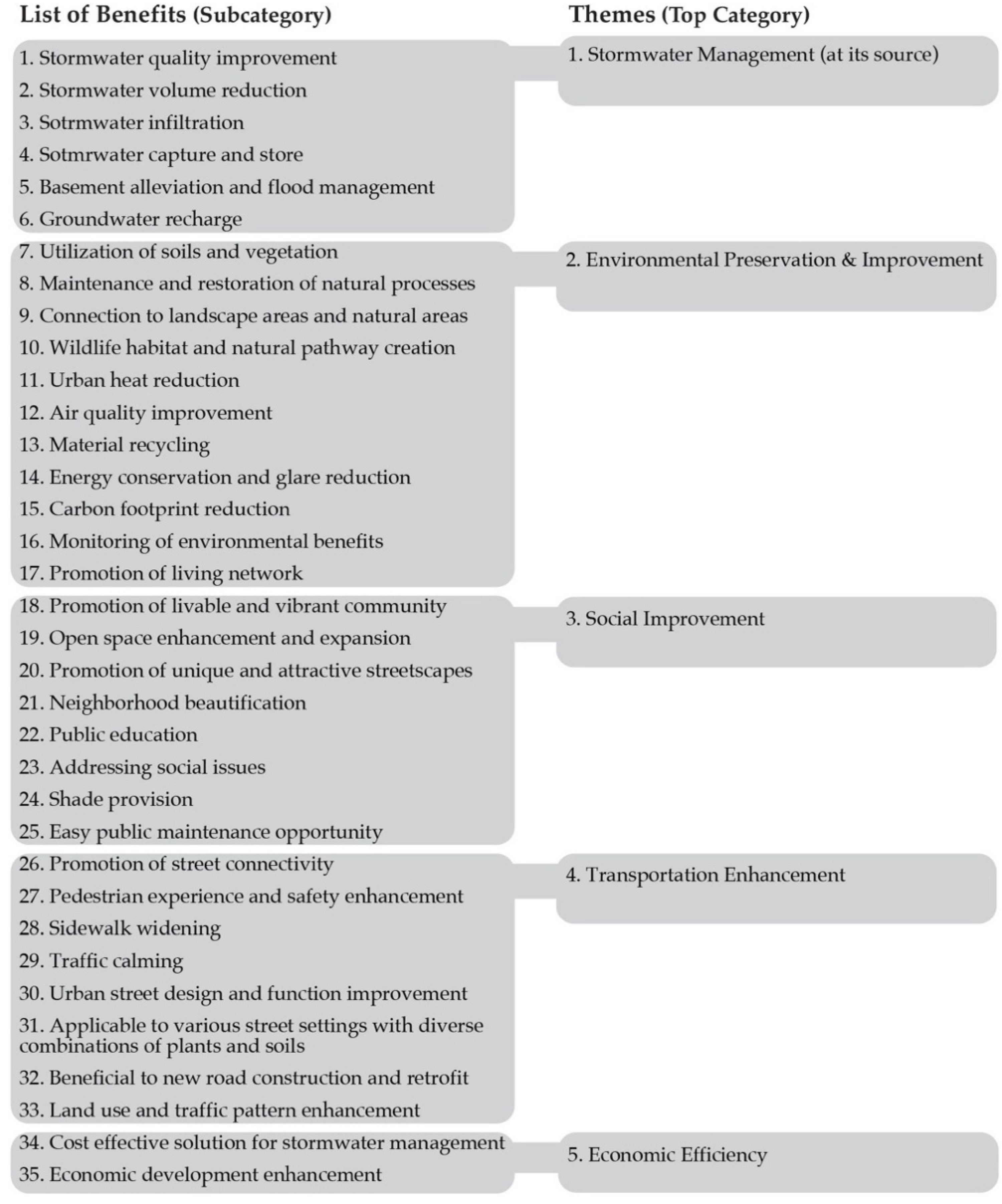

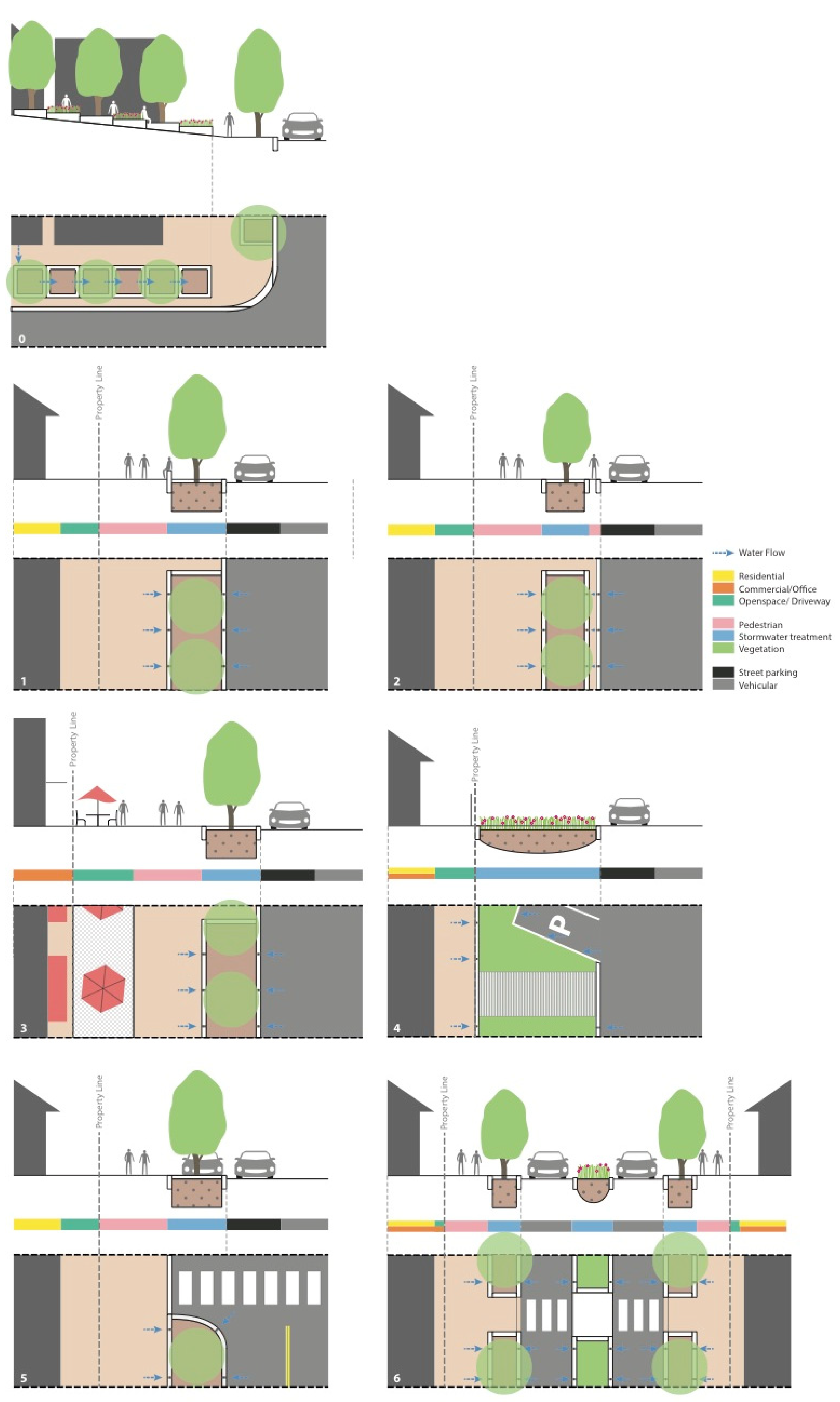
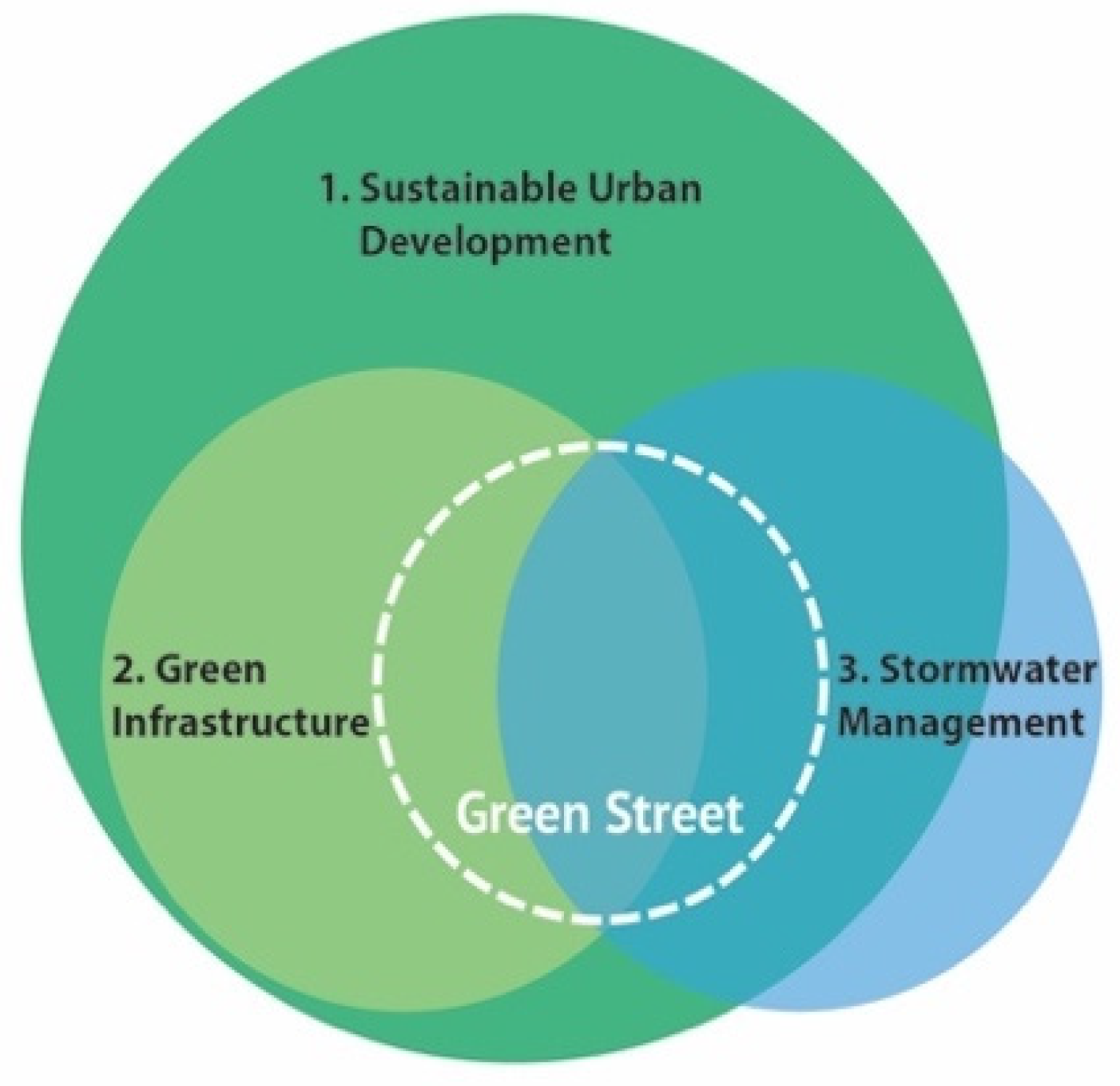
| Source | Definition of Green Streets |
|---|---|
| Portland Environmental Services (2019) [20] | A street that uses vegetated facilities to manage stormwater runoff at its source is referred to as a green street. A green street is a sustainable stormwater strategy that meets regulatory compliance and resource protection goals by using a natural systems approach to manage stormwater, reduce flows, improve water quality, and enhance watershed health. |
| City of Arlington (2019) [21] | A Green street is a street with a vegetated area in the public right-of-way that reduces the volume of stormwater and stormwater pollutants that enter our local streams, the Potomac River, and Chesapeake Bay. |
| Environmental Protection Agency (2019) [22] | Green streets and alleys are created by integrating green infrastructure elements into their design to store, infiltrate, and evapotranspire stormwater. Permeable pavement, bioswales, planter boxes, and trees are among the elements that can be woven into street or alley design. |
| City of Philadelphia (2014) [23] (p. 16) | Green streets present opportunities to manage stormwater while maintaining the primary function of the street for vehicles and pedestrians. A green street acts as a local stormwater management system, capturing stormwater runoff, allowing it to soak into soil, filtering it and, at the same time, reducing the amount of stormwater that would otherwise make its way into Philadelphia’s sewer collection system. |
| Environmental Protection Agency (2009), [24] (p. 1) | A Green street is a street that uses natural processes to manage stormwater runoff at its source. |
| Water Environment Research Foundation (2009) [25] | Green streets are an example of how individual stormwater BMPs are used as elements of a broader program aimed at mitigating a significant source of stormwater pollution. |
| Lukes, Kloss, & Low Impact Development Center (2008), [26] (p.2) | Urban transportation right-of- ways integrated with green techniques are often called “green streets”. Green streets can incorporate a wide variety of design elements including street trees, permeable pavements, bioretention, and swales. Although the design and appearance of green streets will vary, the functional goals are the same: Provide source control of stormwater, limit its transport and pollutant conveyance to the collection system, restore redevelopment hydrology to the extent possible, and provide environmentally enhanced roads. Successful application of green techniques will encourage soil and vegetation contact and infiltration and retention of stormwater. Alternative Street Designs (Street Widths) A green street design begins before any BMPs are considered. When building a new street or streets, the layout and street network must be planned to respect the existing hydrologic functions of the land (preserve wetlands, buffers, high-permeability soils, etc.) and to minimize the impervious area. If retrofitting or redeveloping a street, opportunities to eliminate unnecessary impervious area should be explored. |
| Metro (Portland Metropolitan Area) (2002), p. 2 [27] (p.2) | A “green” street: Is one component of a larger watershed approach to improving the region’s water quality; is designed to incorporate a system of stormwater treatment within its right of way; minimizes the quantity of water that is piped directly to streams and rivers; incorporates the stormwater system into the aesthetics of the community at points where it crosses a stream or other sensitive area; a “green” street is located and designed to ensure the least impact on its surroundings requires a more broad-based alliance for its planning, funding, maintenance, and monitoring. |
| Typical Streets (Non-Green Streets) | Green Streets |
|---|---|
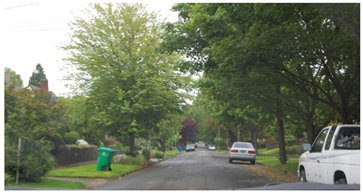 Typical street example 1: Road + Typical Planted Areas (Portland, OR) |  Green street example 1: Safe Crossing + Stormwater Planter on a curb extension (Fremont Streets, Portland, OR) |
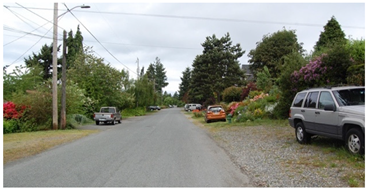 Typical street example 2: Road + Gravel Parking + Planted Areas (Seattle, WA) |  Green street example 2: Underground Cistern + Cascade Stormwater Planter (Maynard Street, Seattle, WA) |
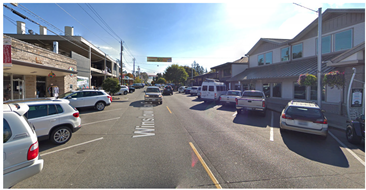 ©2019 Google Typical street example 3: Road + Street Parking + Lack of Planted Areas (Bainbridge Island, WA) |  ©2019 Google Green street example 3: Safe Wide Crossing + Stormwater Planter + Seating (Winslow Way Green Street, Bainbridge Island, Seattle, WA) |
| No application of stormwater management No connection to open space Auto oriented (wider roads) Large impervious surfaces | Integrated with stormwater treatment facilities Integrated with public open space Pedestrian oriented Large permeable surfaces (narrower roads and large planted area) |
| Author | Type/Agency | Place |
|---|---|---|
| Pioneer Valley Planning Commission, 2015 [33] | Manual/ Nonprofit | Springfield, MA |
| City of Philadelphia, 2014 [23] | Design Manual/ Municipality | Philadelphia, PA |
| District Department of Transportation, 2014 [34] | Manual/ Municipality | Washington, DC |
| Carlson, Caughey, & Ward, 2014 [35] | Design Manual/ Municipality | Holyoke, MA |
| City of Cleveland, 2013 [36] | Manual/ Municipality | Cleveland, OH |
| City of Seattle, 2012 [29] | Manual/ Municipality | Seattle, WA |
| Chicago Department of Transportation, 2010 [37] | Handbook/ Municipality | Chicago, IL |
| US Environmental Protection Agency, 2009 [24] | Design Manual/ Federal | Washington, DC |
| Water Environment Research Foundation, 2009 [25] | Design Manual/ Nonprofit | Alexandria, VA |
| Lukes, Kloss & the Low Impact Development Center, 2008 [26] | Handbook/ Federal | Washington, DC |
| Metro Portland, 2002 [27] | Manual/ Municipality | Portland, OR |
| Manuals | Green Street Typology and Terms |
|---|---|
| City of Philadelphia (2014), [23] (pp. 24–37) |
|
| District Department of Transportation (2014), [34] (p. 10) |
|
| City of New York, Department of Environmental Protection, & Bureau of Engineering Design and Construction (2017), [39] (pp. 1–2) |
|
| Portland Environmental Services (2016), [40] (pp. 2–175) |
|
| Lukes, Kloss, & Low Impact Development Center (2008), [26] (pp. 3–7) |
|
| Term | Description of the Stormwater Facility | Example Project |
|---|---|---|
| 1. Intersection | ||
| 1.A. A Type (located within sidewalk) | ||
| 1.A-1 Cell type | Smaller planting area with constructed walls (e.g., concrete boxes) |  Pringle Creek Community, Salem, OR. Image Capture: April 2012 ©2016 Google |
| 1.A-2. Pocket rain garden | Smaller planting area with some natural edges (e.g., stones, grassy side slopes) and irregular shape | |
| 1.B. B Type (extended curb) | ||
| 1.B-1. Extended curb: a type, b type | Smaller planting area with constructed walls (e.g., concrete boxes) |  SE Clay St Green Street, Portland, OR. Image Capture: Mar 2016 ©2016 Google |
| 1.B-2. Pocket rain garden | Smaller planting area with some natural edges (e.g., stones, grassy side slopes) and irregular shape (e.g., traffic island) | |
| 1.C. C Type (detached from sidewalk) | ||
| 1.C-1. Island | Located in the middle of the road | Roundabout, col-de-sac |
| 2. Midblock | ||
| 2.A. A Type (within sidewalk) | ||
| 2.A-1. Cell type: Planter | Smaller planting area with constructed (raised) walls (e.g., concrete boxes) |  College Ave Promenade, Blacksburg, VA |
| 2.A-2. Cell type: Natural | Smaller planting area with some natural edges (e.g., stones, grassed side slopes) and irregular shape | |
| 2.A-3. Swale type: Planter | Linear planting area with constructed walls (e.g., concrete boxes) | 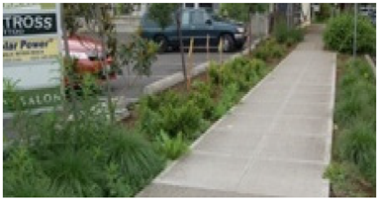 Seven Corners New Seasons Market stormwater planter, Portland, OR |
| 2.A-4. Swale type: Natural | Linear planting area with some natural edges (e.g., stones, grassy side slopes) and irregular shape | |
| 2.A-5. Covered cell: Tree pit | Tree pit with constructed soils covered with tree grate | 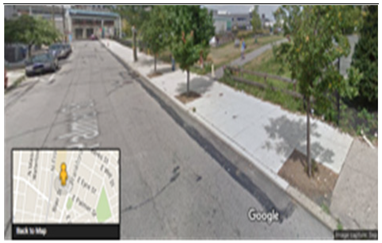 Tree Trench at W Palmer St. ©2016 Google |
| 2.B. B Type (extended curb) | ||
| 2.B-1. Extended curb | Smaller planting area with constructed walls (e.g., concrete boxes) | 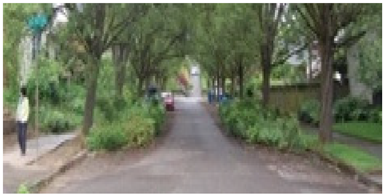 NE Siskiyou Street, Portland, OR |
| 2.C. C Type (detached from sidewalk) | ||
| 2.C-1. Median: Constructed/natural edges | Median planting area with constructed walls (e.g., concrete boxes) or natural edges (e.g., stones, grassed side slopes) | 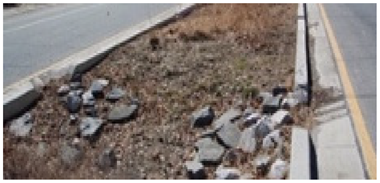 Patrick Henry Drive Green Street, Arlington, VA |
| 3. Combination (Intersection + Midblock) | ||
| 3.A. A Type Combination (within sidewalk) | Combined type located within sidewalk | Large scale application |
| 3.B. B Type Combination (extended curb) | Combined type extended from curb | Large scale application |
| 3.C. Applied Type | Planting area connected to open space, plaza, park, garden, etc. | Integrated system |
| 4. Others | ||
| 4.A. Permeable paving | Permeable paving for pedestrian or vehicular roads | Permeable asphalt, permeable concrete, permeable pavers |
| 4.B. Runnel (open/covered) | Rainwater conveyance | Runnel in planter or sidewalk |
| 4.C. Cistern (above/underground) | Rainwater harvesting for reuse (e.g., irrigation) | Cistern connected to the stormwater facility |
| 4.D. Fountain | Located on slopes or designed for ornamental purposes | Cascades, fountain |
| 4.E. Street furniture | Furniture to support site users | Benches, light fixtures, information kiosk |
| 4.F. Structure (shade/wall) | Spatial composition or safety consideration | Shade structures, walls, seat walls |
| Green Street Projects | Descriptions |
|---|---|
SEA (Street Edge Alternative) Street Project, Seattle, WA (2nd Ave. NW) ©2019 Google | Land Use: Residential Typology: 2.A-2. Cell type: Natural Catchment Area: Road Integrated Features: Vegetation, flushed curb for water flow into the cell, angled parking, curvilinear street |
Birkenstein Innodrain, Birkenstein, Germany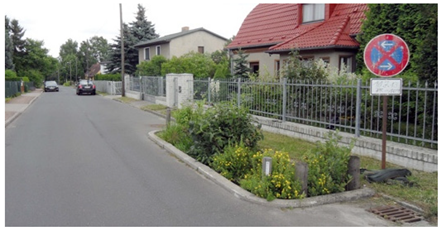 | Land Use: Residential Typology: 2.B-1. Extended curb Catchment Area: Road Integrated Features: Vegetation, raised curb, reflection pole for vehicle safety, traffic calming |
Smart Planter, Seoul, Korea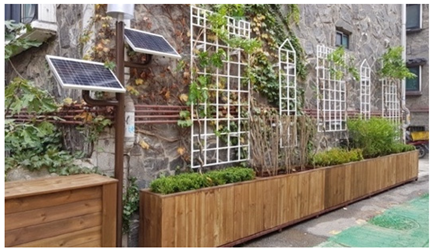 | Land Use: Residential Typology: 2.A.-1. Cell type: Planter Catchment Area: Roof Integrated Features: Vegetation, wall trellis, smart self-watering system powered by solar panel |
© 2019 by the author. Licensee MDPI, Basel, Switzerland. This article is an open access article distributed under the terms and conditions of the Creative Commons Attribution (CC BY) license (http://creativecommons.org/licenses/by/4.0/).
Share and Cite
Im, J. Green Streets to Serve Urban Sustainability: Benefits and Typology. Sustainability 2019, 11, 6483. https://doi.org/10.3390/su11226483
Im J. Green Streets to Serve Urban Sustainability: Benefits and Typology. Sustainability. 2019; 11(22):6483. https://doi.org/10.3390/su11226483
Chicago/Turabian StyleIm, Joowon. 2019. "Green Streets to Serve Urban Sustainability: Benefits and Typology" Sustainability 11, no. 22: 6483. https://doi.org/10.3390/su11226483
APA StyleIm, J. (2019). Green Streets to Serve Urban Sustainability: Benefits and Typology. Sustainability, 11(22), 6483. https://doi.org/10.3390/su11226483





